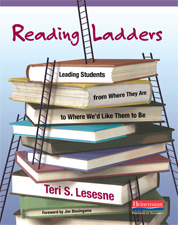Climbing Reading Ladders
Reading Ladders: Leading Students from Where They Are to Where We’d Like Them to Be
By Teri S. Lesesne
(Heinemann, 2010 Learn more)
I anticipated reading the latest educational ideas from Teri S. Lesesne in Reading Ladders because I am constantly looking for ways to engage my middle school readers and find ways to improve their enjoyment of reading. Lesesne has a solid foundation of ideas and has given me ideas to ponder, though there are times that her ideas seem like something geared more to larger communities than the rural population in which I teach.
Moving up the ladder
The basis of the reading ladder is to find where the individual student’s reading ability and interest lie and to work with each student to continue to find books he or she might enjoy, while at the same time gradually increasing the reading level to keep the challenge level there. The hardest part of teaching middle school students is trying to overcome the “I Hate Reading” mantra that so many of them spout, and Lesesne has many ideas that the average teacher might not have considered to get past that familiar chant.
 Nonfiction for pleasure!
Nonfiction for pleasure!
An area I had not considered much is finding more non-fiction materials for students to read for pleasure. Every state has some standardized test that focuses largely on non-fiction readings, but many of us continue to use non-fiction only in preparation for these tests. In reality, according to Lesesne, we could reach many of these reluctant readers by offering them non-fiction books about activities or items they have an interest in, be it a hobby or a favorite sport. (Editor’s note: Find more of Lesesne’s ideas about nonfiction reading ladders, including history topics, at her Reading Ladders wiki.)
Simple ideas like this form a solid base for the notion of creating a reading ladder for each student. Lesesne provides many example ladders to show how to track the progress of students though one or more years. Finding a starting point and an ultimate goal can be tricky, but she details the set-up of this idea quite well.
One size doesn’t fit all
To Lesesne’s credit, she doesn’t claim that her ideas are a cure-all for the reading woes we see in our classrooms. She is very clear about taking her ideas and customizing them for what works in our individual settings. Too many other authors I’ve read seem to think they have the ultimate answer, but any teacher with a modicum of experience knows that ideas change, and we have to mold and shape things to fit in our classrooms.
Implementation challenges
I have two main issues with Lesesne’s otherwise good plan. The first is that I don’t have the time to keep up with all the young adult literature that is out there. I wouldn’t even know where to begin in making recommendations for many of my students. I can’t count on our media center specialist either, since she spends most of her time with our elementary students.
The other problem deals with the sheer amount of work this would take to develop ladders for all my students. When you see 130 students a day, who has the time or energy to fit together a plan for each of them? Granted, some might fit in the same general pattern, thus eliminating some of the work, but this thought staggered me.
A valuable quick read
That being said, I do plan to take some of the basic ideas, such as keeping better track of what my students read, and adapting them into my classroom. A visual ladder for the students will hopefully perk their interests and might even inspire some others to talk about and try out new books that they see others have read.
Kudos to Lesesne for a good idea. Despite some flaws, her humbleness and unique perspective make Reading Ladders worth a look. At 90 pages, it won’t take you long to read, and if you only gain one thing to use in your classroom, you’ll be able to count it as time well spent.
Mark A. Domeier is an English teacher at New Richland-Hartland-Ellendale-Geneva schools in Minnesota, where he has taught middle school English for 17 years. He has a BS degree from Winona State University and a Master’s degree from St. Mary’s University, Minnesota. Domeier recently published his debut novel, Heroics 101 (available on Amazon), a middle grades novel about realistic super heroes. He is also a weekly columnist for the NRHEG Star Eagle, a local newspaper.




































